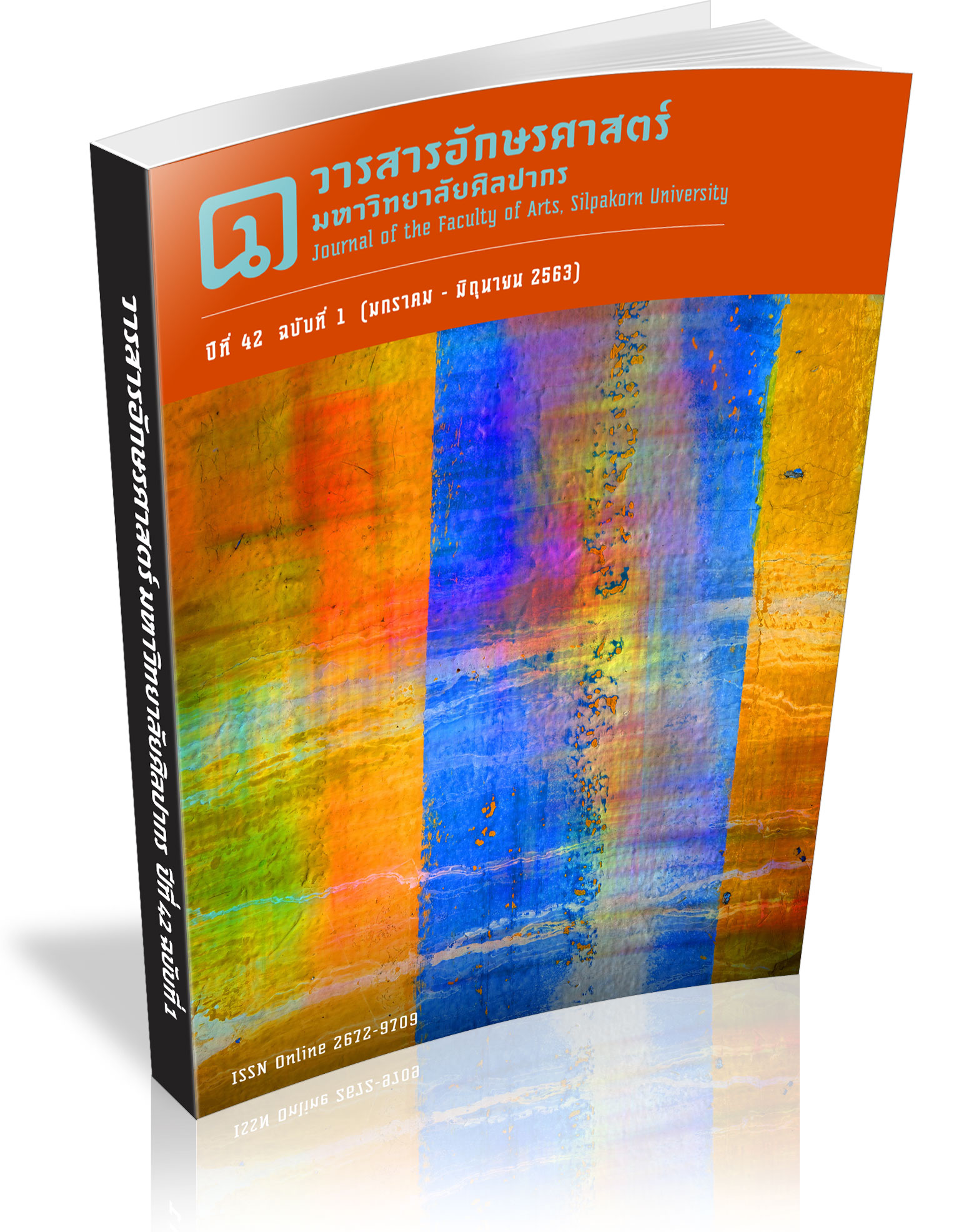Prince Damrong Rajanubhab Formation of Historical and Archaeological Knowledge in Siam during 2440-2450 BE.
Keywords:
Inspection, Prince Damrong Rajanubhab, History of Siam, Archaeology of SiamAbstract
This article aims to present the process of gathering information and forming local historical and archaeological Siamese locality through the travel for inspection of civil servants and the minister of the Ministry of Interior in Siamese provinces during the period that Prince Damrong Rajanubhab was the minister (2435–2458 BE.), which was when Siam’s elite established an absolute monarchy and integrated it into the centralized system. The trend of studying historical and archaeological knowledge of colonial states has spread to Siam stimulating the interest of noblemen and civil servants, especially in the Ministry of Interior, of gathering relevant information such as stone inscriptions annals and city legends. This information helps people compile and link the history of each locality with the history of Siam. Forming knowledge through the travel for inspection is also a significant part of recoding national history for clarifying the identity of Siamese along with creating legitimacy towards local area management under the policy of centralization.
Downloads
References
Projects. (In Thai)
Chanamool, S. (2007). “Thai Nation” in the view of progressive intellectuals. Bangkok: Matichon. (In Thai)
Coedes, G. (1961). Collection of Siam inscriptions Part 2 Inscriptions from Dvaravati, Crivijaya and Lavo. 2nd ed. Bangkok: Sivaporn. (In Thai)
DamrongRajanubhab. (1930). Discoures named Ancient Artifacts Preservation. Bangkok: Soponpipatthanakorn Printing. (In Thai)
DamrongRajanubhab. (1958). A variety of travel section 3 : A story of Monton Phetchabun.Bangkok: Thaibabrian. (In Thai)
DamrongRajanubhab. (1978). To Phya Anuman Rajadhon. Correspondence Between Prince Damrong and Phya Anuman Rajadhon. Bangkok: Sathirakoses Nagapradipa Foundation. (In Thai)
DamrongRajanubhab. (2016). Archaeology tales. Bangkok: Thai Quality Book. (In Thai)
Dechdevaporn, P. (2012). Wachirayan Tales Vol. 12. Bangkok: Director Office of Literature and History Fine Arts Department. (In Thai)
Disakul, P., M.C. (1972). Life and Work of Damrong Rajanubhab. Phranakorn: Bannakhar Press. (In Thai)
Fine Arts Department. (1973). City in northeast. Bangkok: Chuanchuen. (In Thai)
Hoaherm, P. & Chaiwanichaya, S. (2018). The Development Policy of Isan Region By Siam Government From The Reign of King Rama VI to The Reign Rama VII during 1910–1934. Journal of History, 43(1), 84-109. (In Thai)
Khuttharanon, S. (2012). Miscellany of Thai History Vol. 3. Bangkok: Director Office of Literature and History Fine Arts Department. (In Thai)
Krairiksh, P. (2002). Sukothai and Ayutthaya Arts : The image that must be changed. Bangkok: Amarin book center. (In Thai)
M.R. Amorawongwichit. (1984). The legend of Nakhon Champassak. Phranakorn: Fine Arts Department. (In Thai)
M.R. Amorawongwichit. (1996). The Annval of Monton Isan. Bangkok: Wacharin Press. (In Thai)
Mulsilp, W. (2008). The Association of Siam Investigation about ancient artifacts. Journal of the Historical Society, 34-35, 1-26. (In Thai)
Nasriken, A. (2005). Isan in the Perception and Attitude of Bangkok Ruling Elites from the Anuwong Rebellion in 1826 to the Revolution in 1932. Master Thesis in History, Chulalongkorn University, Thailand. (In Thai)
National Archives of Thailand. (1898). M. 2.14/61 Damrong Rajanubhab travel for inspection at Muang Nakorn Chaisri [21 August 117]. (In Thai)
National Archives of Thailand. (1905). GR. 5 B./40 Gathening an antient artifact in the Emerld Bhuddha Temple [11 – 13 February 124]. (In Thai)
National Archives of Thailand. (1906). GR. 5 B/41 Tracing of Muang Phatthalung lineage and their annals [21 July 125]. (In Thai)
National Archives of Thailand. (1915). R.6 B.12/16 Travel Inspection at Muang Chaliang [6 March 1915]. (In Thai)
Parinyaphon, K. (2015). Muang Sakon Nakhon Chronicle issue of Rong Ammat to Phra Boribansupakij (Kamsai Sirikhan). Sakon Nakhon: Sakon Nakhon Printing. (In Thai)
Peleggi, M. (2002). Lords of Things: The Fashioning of the Siamese Monarchy’s Modern Image. Honolulu: University of Hawai’I Press. Phramongkutklao Chaouhua. (1977). Travel in Phra Ruang‘s Town. Bangkok: Thaikasem. (In Thai)
Potjanalawan, P. (2007). Politic and Society in Architectural Arts : Siam Era, Applied Thai, and Nationalism. Bangkok: Matichon. (In Thai)
Potjanalawan, P. (2017). The Production of Colonial Space in Payap Circle by Siam's Knowledge of History and Archaeology. Local Administration Journal, 10(3), 106-123. (In Thai)
Potjanalawan, P. (2018). Constucting Official Thai Art : Art History and Nation Building During 1865–1982 A.D. Doctor Dissertation, Ph.D. in History, Chiang Mai University, Thailand. (In Thai)
Prakitnonthakan, C. (2017). Early Art Historical Writings and the Rise of Siamese's Absolute Monarchy. NAJUA: History of Architecture and Thai Architecture, 14, 89.
Puaksom, D. (2018). Drops of Blood, Inscriptions and Printing presses : Regarding the Knowledge/Truth of the Siamese Elite in 23252411 BE. Bangkok: Illumination Editions. (In Thai)
Ritthiphairot, K. (2005). G.E. Gerini and the Origins of Siamese Archaeology. Muang Boran Journal, 31(3), 48.
Saengthong, P. (2015). Legends and Local Mythic Naratives In Southern Thailand. Bangkok: Gypzy. (In Thai)
Sanrat, T. (2014). Mueng Ubon Ratchathani In Thai historiography B.E. 2477-2530. Journal of History, 39, 1-24. (In Thai)
Saraya, T. (1996). Local History: Human Society Related History. Bangkok: Muang Boran. (In Thai)
Sattayawuthiphong, P. (2008). Archeology Club and the Development of Siamese History. Journal of the Historical Society, (30), 240. (In Thai)
Soontravanich, C. (1972). The Evolution of Writing History from Chaophraya Thiphakonwong to His Royal Highness Prince Damrong Rajanuphab-Study and Compare the Royal Annals during King Rama II period of Rattanakosin Era. Silpakorn Journal, 16, 68-70.
Wannachat, A. (2010). The Siamese Elite's Knowledge of “Isan”, 1890–1932. Master Thesis in History, Chulalongkorn University, Thailand. (In Thai)
Wattana, S. (1990). Absolute Monarchy of Siam. Journal of Social Sciences and Humanities, 17(1), 26. (In Thai)
Winichakul, T. (2017). Thais/ Others : Regarding Others of Thainess. Nonthaburi: Sameskybooks. (In Thai)
Downloads
Published
How to Cite
Issue
Section
License
ผู้เขียนบทความต้องยินยอมในข้อกำหนดต่าง ๆ ของวารสารก่อนส่งบทความตีพิมพ์




